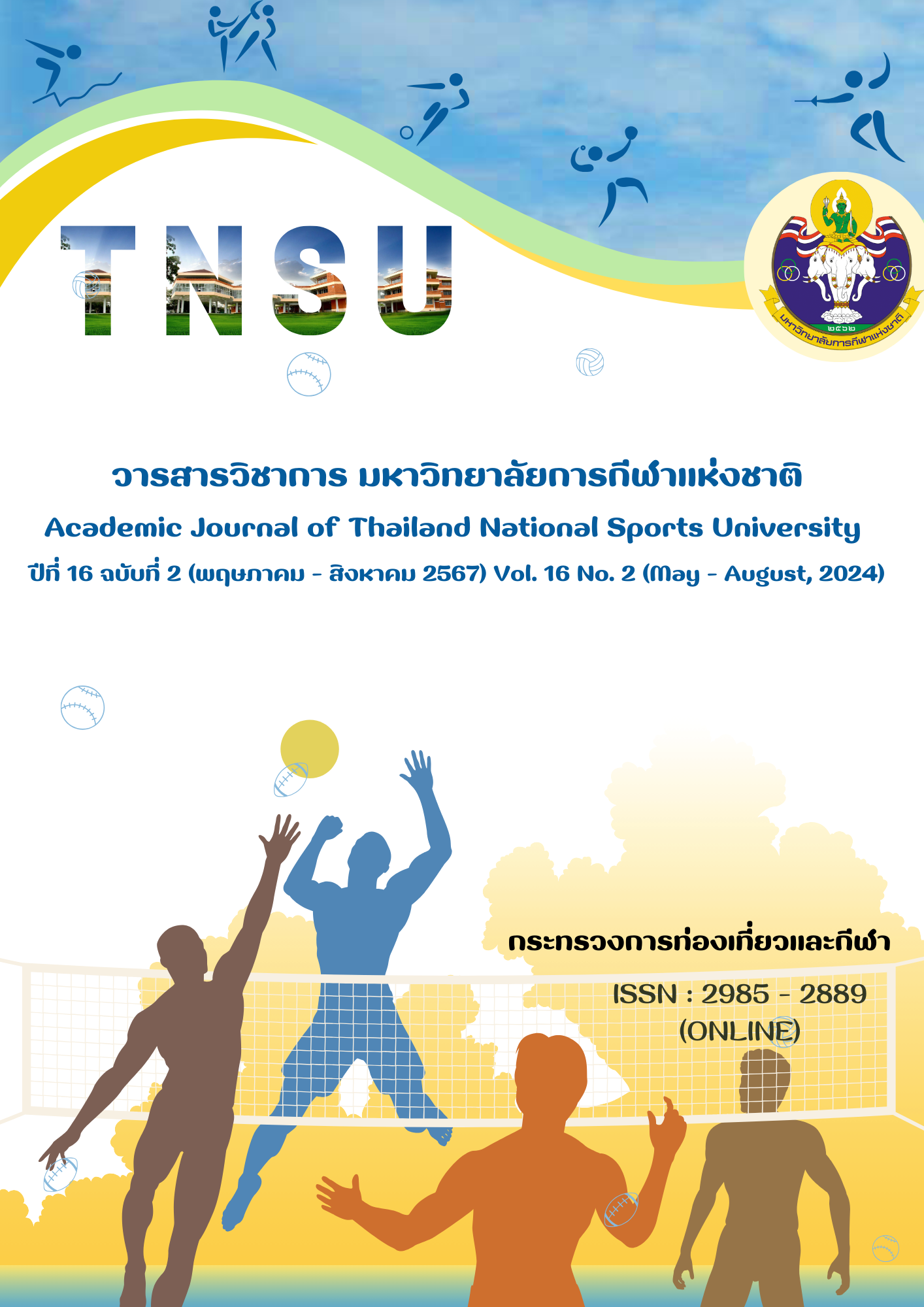EFFECTS OF HEALTHY EXERCISE IN THE ERA OF THE NEW NORMAL
Main Article Content
Abstract
This quasi - experimental research aimed to compare physical fitness before and after participating in a healthy exercise program in the new normal life. Thirty samples of female educational personnel from Thailand National Sports University Chiang Mai Campus were selected by multi - stage sampling. The research tools were an exercise program for health in the new normal life, a physical fitness assessment before the program, and 4, and 8 weeks after the program. Data were analyzed using repeated-measures one - way ANOVA statistics. The research results showed that the subjects had a mean age of 36.13 ± 9.09 years. Physical activity averaged 359.17 ± 192.33 minutes per week or 1,425.85 ± 751.99 MET minutes per week. They also had sedentary behavior on average 397.33 ± 241.08 minutes per day after joining the program for 4 weeks, as well as a statistically significant change in the cardiovascular system endurance, leg muscle strength and arm muscle strength increased (p < 0.001), BMI decreased (p < 0.001), but there was no difference in flexibility (p = 0.108). After participating in the program for 4 weeks, there was a statistically significant increase in cardiovascular endurance, leg muscle strength, and arm muscle strength (p < 0.001). Slenderness also increased (p < 0.05), while BMI decreased (p < 0.001). Exercise for health in the new normal life helps to improve physical fitness in all aspects, including BMI, cardiovascular endurance, leg muscle strength, arm muscle strength, and flexibility.
Article Details

This work is licensed under a Creative Commons Attribution-NonCommercial-NoDerivatives 4.0 International License.
The published article is a copyright of the Academic Journal of Thailand National Sports University. The passage appeared in each article in this academic journal is a perspective of each author which is not related to the journal. Each author is required to be responsible for all components of his/her own article. If there are any mistakes, each author must be responsible for those mistakes on his/her own.
References
Alongkorn Srilert, & Sarawut Saengkham. (2016). Attitudes, behaviors, factors affecting physical activity of Northern College personnel. and personnel at the Hi - Tech School of Technology. Faculty of Public Health and Environment Northern College: Tak.
Behavior and Social Phenomena Research Group. (2023). Physical activity situation of the Thai population in 2022 and guidelines for physical activity promotion in 2023. Retrieved from https://tpak.or.th/th/article/647
Buchheit, M., & Laursen, P. B. (2013). High - intensity interval training, solutions to the programming puzzle: Part I: cardiopulmonary emphasis. Sports Medicine, 43(5), 313 - 338.
Bureau of Sports Science, Department of Physical Education, Ministry of Tourism and Sports. (2016). Handbook of physical fitness tests and benchmarks for people aged 19 - 59 years (2nd ed.). Bangkok: OK Mass.
Department of Mental Health. (2020). New normal. Retrieved from https://dmh.go.th/news/view.asp?id=2288
Division of Physical Activity and Health, Department of Health, Ministry of Public Health. (2020). Action plan physical activity promotion 2021 - 2022. Samut Prakan: TS Interprint.
Keating, S. E., Machan, E. A., O'Connor, H. T., Gerofi, J. A., Sainsbury, A., Caterson, I. D., & Johnson, N. A. (2014). Continuous exercise but not high intensity interval training improves fat distribution in overweight adults. Journal of Obesity, 2014, 834865. doi: 10.1155/2014/834865.
LaForgia, J., Withers, R. T., & Gore, C. J. (2006). Effects of exercise intensity and duration on the excess post - exercise oxygen consumption. Journal of Sports Sciences, 24(12), 1247 - 1264.
Morton, R. W., Oikawa, S. Y., Wavell, C. G., Mazara, N., McGlory, C., Quadrilatero, J., Baechler, B. L., Baker, S. K., & Phillips, S. M. (2016). Neither load nor systemic hormones determine resistance training - mediated hypertrophy or strength gains in resistance - trained young men. Journal of applied physiology (1985), 121(1), 129 - 38.
Opplert, J., Babault, N. (2018). Acute effects of dynamic stretching on muscle flexibility and performance: An analysis of the current literature. Sports Medicine, 48, 299 – 325.
Pornpimol Rattanawiwatpong, Arom Khunphasee, Chakarg Pongurgsorn, & Patrawut Intarakamhang. (2006). Validity and reliability of the Thai version of short format international physical activity questionnaire (IPAQ). Journal of Thai Rehabilitation Medicine, 16(3), 147 - 160.
Poomchat Konfoo, Ouaypon Tungthongchai, & Boonlerst Ou-tayanik. (2021). Effects of combined exercises program on muscle strength and flexibility among working age women of office of educational administration Kasetsart University. Journal of Kasetsart Educational Review, 36(1), 118 – 127.
Tanongsak Tongsrisuk. (2023). Effects of self - directed program on exercise with Muay Thai skills on the development of physical fitness in untrained adults. Education Journal Faculty of Education, Nakhon Sawan Rajabhat University, 6(2), 83 - 93.
Thida Tongvichean, Yupin Aungsuroch, & Sunida Preechawong. (2019). Effect of self - management exercise program on physical fitness among people with prehypertension and obesity: A quasi - experiment study. Pacific Rim International Journal of Nursing Research, 23(1), 6 - 17.
Thailand Physical Activity Knowledge Development Canter, Institute for Population and Social Research Mahidol University, & Thai Health Promotion Foundation. (2020). Physical activity in Thailand after COVID - 19 Pandemic. Nonthaburi: Parbpin.
Sirinapa Jaimuang. (2023). Effect of interactive e - Games on the health of students attending online learning classes during COVID - 19 pandemic. Health Science Journal of Thailand, 5(1), 18 - 24.
Waranya Thongbai, Phong - ek Suksal, & Kajornsak Roonprapunta. (2022). Effects on Hight intensity interval training on health - related physical fitness in overweight secondary students. Science and Technology Northern Journal, 3(4), 28 - 40.


